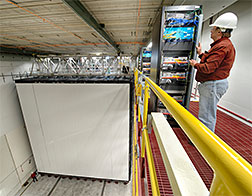- Number 397 |
- September 16, 2013
Fermilab sends first neutrino beam to NOvA experiment

The first modules of the NOvA detector in
Minnesota, still under construction,
are taking data.
DOE’s Fermilab has switched on its newly upgraded neutrino beam, soon to be the most intense in the world. The laboratory spent the past 15 months upgrading its accelerator complex in preparation for the NOvA experiment, which will study neutrinos using a 200-ton particle detector at Fermilab and a 14,000-ton detector in northern Minnesota.
Neutrinos are light, neutral particles that rarely interact with other matter. About a decade ago, scientists discovered that neutrinos must have mass, but they must weigh at least a million times less than electrons. The NOvA experiment aims to determine which of the three known types of neutrinos is the heaviest and which is the lightest. To do that, Fermilab will send intense neutrino beams through the earth to the huge NOvA detector in Minnesota.
Fermilab scientists and engineers have reconfigured the accelerator complex to halve the time it takes to accelerate bunches of protons and slam them into a carbon target. The teams updated the radio-frequency cavities that boost the proton’s energy, the kicker magnets that guide them, and the target they crash into—a collision that releases a spray of other particles. They’ve replaced one of the two magnetic horns that focus the spray of particles before it decays and produces neutrinos.
The first modules of the NOvA detector in Minnesota, still under construction, are now taking data. The construction of the NOvA detector will be complete in 2014. Two other neutrino experiments, MINOS+ and Minerva, benefit from the improved neutrino beam as well.[Kathryn Jepsen, 630.840.3351,
media@fnal.gov]
